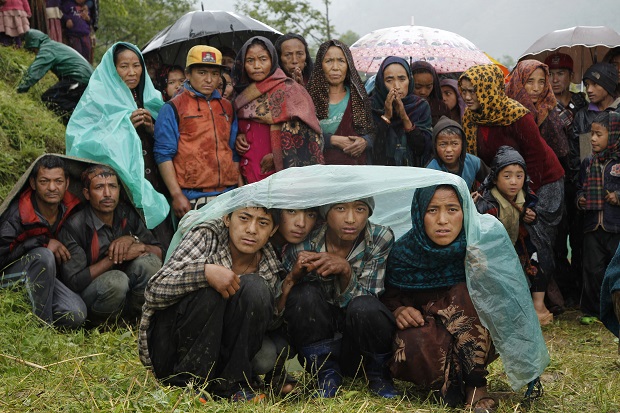
Villagers wait in the rain as an aid relief helicopter lands at their remote mountain village of Gumda, near the epicenter of Saturday’s massive earthquake in the Gorkha District of Nepal, Wednesday, April 29, 2015. In Kathmandu, some survivors wishing to escape the lack of food and water clashed with riot police over the failed promise of authorities to provide buses going to the rural areas. AP
KATHMANDU, Nepal – Desperate survivors of an earthquake that killed more than 5,000 people clashed with riot police in Nepal’s capital on Wednesday, as the United Nations appealed for $415 million for the devastated Himalayan nation.
Supplies of food and water are running thin and aftershocks have strained nerves in ruined Kathmandu, home to some 2.5 million before it was shattered by Saturday’s 7.8 magnitude quake.
Desperate to leave, thousands of people gathered outside the main bus station after the government promised to lay on special services to far-flung rural areas.
But when the buses failed to materialize, anger surged and scuffles broke out between the crowds and riot police who were sent to try to contain the situation near parliament.
‘Why so slow?’
Some protesters forced a truck carrying drinking water off the road and climbed on top of it, throwing the bottles to the crowd.
“We’ve been left starving in the cold and the best this government can give us is this queue. Why are they so slow?” asked Rajana as she lined up along with thousands of others for a bus to her home village.
“I keep hearing on the news that all governments and aid agencies are here, but where are they? Our government is totally absent. Forget shelter, they couldn’t even give us water,” said Rajana, who goes by one name.
Israel advised its nationals to leave Nepal for “health and security reasons”.
Hundreds of thousands of people across the country settled down for a fifth night under tents. Their homes were either wrecked or were feared to be on the verge of collapse.
But with the number and scale of the aftershocks subsiding, some residents returned to salvage possessions from the ruins of their homes, grabbing everything from fridges to family chickens.
UN launches urgent appeal
On Wednesday, the United Nations appealed for $415 million for Nepal, saying that around 70,000 houses had been destroyed and another 530,000 damaged.
One estimate has put the cost of reconstruction at $5 billion.
“There have been some weaknesses in managing the relief operation,” Communications Minister Minendra Rijal told Nepal’s Kantipur Television, acknowledging the government had been overwhelmed by the devastation from the deadliest quake in Nepal since 1934.
“The disaster has been so huge and unprecedented that we have not been in a position to meet the expectations of the needy people,” he added.
There was also desperation in devastated rural areas. People have been pleading to be airlifted out when the occasional helicopter has reached their villages with relief supplies.
In Dolakha, east of Kathmandu, angry residents smashed windows of a local administrative building, said Chief District Officer Prem Lal Lamichhane.
No aid yet
“Over 200,000 people are homeless. We’ve been told that materials are on their way, but we haven’t received them yet,” the official pleaded.
A total of 5,057 people are known to have died in Nepal and around 100 more in neighboring India and China.
Around 8,000 were injured while the UN estimates that eight million people have been affected.
Around 1.7 million children are now in urgent need of aid in the worst-hit areas, according to the UN children’s agency.
“Although I am heartened and encouraged by the progress of the response to date, efforts need to be maintained and stepped up to ensure vital assistance reaches all the affected, especially those in the remote areas,” said UN resident coordinator for Nepal, Jamie McGoldrick.
Earlier McGoldrick said that the Nepalese government had told organizers of the relief effort there was no need for further outside help, with teams from many countries on the ground.
US President Barack Obama said his country would do “all it can” in a phone call with Nepalese Prime Minister Sushil Koirala on Wednesday, after expressing his “deep condolences” for the loss of life, according to a White House spokesman.
‘So thirsty he drank his own urine’
Among the dead were 18 climbers who were at Mount Everest base camp when an avalanche from the quake flattened everything in its path. The victims included two Americans, an Australian and a Chinese national.
Police Wednesday released a list of 33 foreigners still missing since the earthquake, including 15 Israelis, five Canadians, three Bangladeshis and three French nationals.
Rescuers underlined the daunting scale of the task.
An Indian Air Force plane trying to reach one of the worst-hit areas near Kathmandu was forced to drop packets of noodles and sacks of rice from the air after being unable to land, with the ground below looking like the set of a war movie.
Rubble everywhere
“We tried for 20 minutes but there was no possible way we could land. There was debris and rubble everywhere,” Wing Commander Abhijit S. Bali told AFP at Larpak village some 80 kilometres (50 miles) outside the capital.
An Indian military helicopter had better luck in the Gorkha Valley Wednesday, airlifting around a dozen mainly Slovakian trekkers to safety.
And French rescuers plucked one man from the rubble of his Kathmandu hotel late Tuesday after he was trapped under masonry for around 82 hours.
Barely conscious and covered in dust, Rishi Khanal was taken to hospital after being fitted with a neck brace and a drip attached to his right arm.
“He said he was so thirsty that he even drank his own urine,” his brother-in-law Purna Ram Bhattarai told AFP.